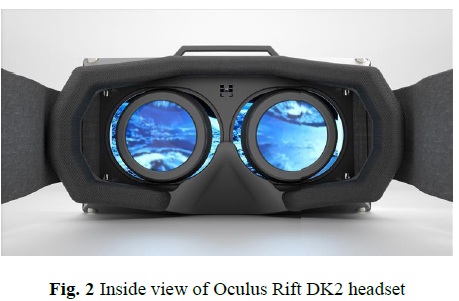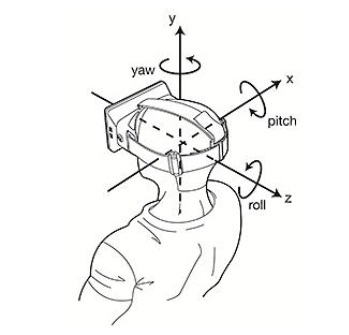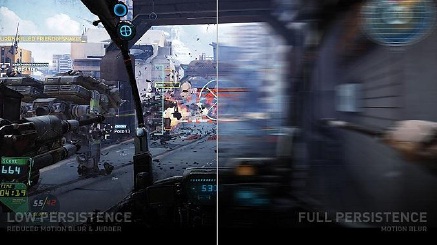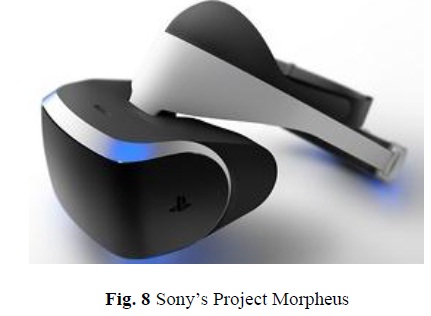





Published on Apr 02, 2024
Virtual Reality is a currently-expanding field which gives the users an experience of being in a real environment. Currently under research, VR gives the user an impression of the real scene. In this paper we review the Oculus Rift and then compare it with Sony’s Project Morpheus. Both the head-mounted displays are touted to go head-to-head against each other, when released commercially, with games already under development for both of them.
Virtual reality (VR) is a technology used for interaction with a computer generated environment. It is a simulated version of the real environment and can be experienced in three dimensions. Screens are used to display this visual experience. It also provides an interactive experience wherein the display is according to the tactile feedback received from the user.
The idea of a lifelike experience in a simulated environment is what drives the entertainment industry to evoke virtual reality concepts. Examples include the US air forces who practice their parachuting skills by wearing a headset that simulates the environment of the user jumping off a plane and flying through the air. Head mounted display pieces have been used by wearers to place on their heads and see virtual reality in its full glory.

Virtual reality has been described by some novelists as divided into seven different segments- network communications, total body immersion, tele-presence, artificial, immersion, interactivity and simulated reality. Previously the technology for VR was very primitive and needed a boost. Fortunately, the team behind Oculus Rift realized this, and the technology was finally here to do proper virtual reality. They built the first prototype of VR that was very usable and now its second iteration is generating waves in the VR industry. It is a head-mounted display that works in tandem with computers.
The Oculus Rift is a headset which allows its user to feel like they are actually in a game just by wearing it. Picture a set of ski goggles in which a large mobile phone screen replaces the glass material. The screen displays two images adjacent to each other, one for left eye and one image for right eye. The combination of lenses is placed above screen, enabling the zoom in-out and re-shaping the picture for both the eye, thereby creating a stereoscopic 3D image. Rift devices monitor the wearer's head motions by the embedded sensor and accordingly adjust the image. The latest version of the Oculus Rift is bolstered by an external positional-tracking accessory, which helps track head movements more accurately. The result is the sensation that you are looking around a very realistic 3D world.
Cost : INR 21000
Display Resolution: 960 x 1080 (1.13:1)
Display Technology: OLED
Field of View (degrees): H: 90°
Pixels Per Inch (PPI): 441
Total Pixels (per eye): 1,036,800
Weight (headset): 440g
Stereoscopic 3D capable: Yes
Audio: Bring Your Own Audio
Inputs: HDMI 1.4b, USB, IR Camera Sync Jack
Head Tracking: Yes
Positional Tracking: Yes
Refresh Rate: 75 Hz, 72 Hz, 60 Hz
Persistence: 2 ms, 3 ms, full
Viewing Optics: 100º Field of View (nominal)
Cable: 10‘ (detachable)
Input: HDMI 1.4b
USB device: USB 2.0
USB host: USB 2.0 (requires DC Power Adapter)
Camera USB: USB 2.0
Sensors: Gyroscope ,Accelerometer, Magnetometer
Update Rate: 1000 Hz
Sensor: Near Infrared CMOS Sensor
Update Rate: 60 Hz
The head tracking software in the Oculus Rift replicates the way the user would look around in the real world thus allowing the user to look around the virtual world in the same manner. The player‘s head movement is continuously analyzed and used to control the view, rather than relying on a mouse or analogue stick to turn your view in the game. The new Oculus VR sensor supports sampling rates up to 1000 Hz, thus helping minimize the time between the player‘s head movement and the game engine receiving the sensor data to roughly 2 milliseconds. Since the increased sampling rates provide a denser dataset to integrate over, orientation error is also reduced, which syncs the player‘s real-world movements more with the game
The Oculus Rift headset contains a gyroscope, accelerometer, and magnetometer. To determine the orientation of the user‘s head in the real world, we combine the information from these sensors through a process known as sensor fusion. It is also used to synchronize the user‘s virtual perspective in real-time. The data provided by these sensors help to accurately track and portray yaw, pitch, and roll movements. A very simple model of the user‘s head and neck is useful in accurately translating sensor information from head movements into camera movements.
This is denoted as the head model, and it represents the fact that movement of the head in any of the three directions actually pivots around a point roughly at the base of your neck—near your voice-box. Depth perception and the uncomfortable feeling normally associated with VR when you rotate your head are solved by producing a translation at your eyes thereby creating a motion parallax.

The most valuable data for head orientation tracking is provided by the gyroscope, which reports the rate of rotation (angular velocity) around X, Y and Z axes in radians/second. The Oculus SDK can determine the direction of the Rift relative to where it began since it continuously collects angular velocity samples over time. Although the gyroscope provides orientation relative to the starting point, it poses two challenges: it can‘t provide the original orientation of the headset and it is subject to a small amount of drift over time i.e. imagine re-orienting your head back to perfect center but in the game you‘re now looking slightly left or right.
These are obviously significant issues for any VR game with a fixed reference point (i.e. a game with a cockpit, where your head‘s orientation does not affect the position of whatever car/plane/mech you‘re piloting). Nevertheless, by leveraging the accelerometer to estimate the ―down‖ vector and our magnetometer to measure strength and direction of the magnetic field, we can combine them to allow for correction of drift in all three axe
Low persistence relates to how quickly the displays refresh. The switch from LCD (in DK1) to OLED (in DK2) displays played a big role in doing away with the smearing or ghosting of objects. Now only the updated frames are displayed to the user, as they are drawn by the GPU only the updated frames are displayed to the user. DK2 uses a low persistence OLED display to eliminate motion blur and judder, two of the biggest factors in causing simulator sickness. This newly-introduced feature helps makes the scene appear visually stable.

The new hardware has HD displays, suspected to be 720p display, as the individual pixels could still be seen, creating a "screen door" effect. The goal of the Oculus team is to accomplish greater resolutions and attain even lower latency. Their aim is to lower the current number from around 30 ms to under the sub-20 ms range for the final consumer version. Oculus VR defines latency as the total time between movement of the user‘s head and the updated image being displayed on the screen (―motion-to-photon‖), and it includes the times for fusion, image transmission, rendering, sensor response and display response. Reducing latency is critical to a comfortable and immersive VR experience. One of the unique points that separate Rift from its competitors is its low latency head tracking.
Interfacing
The Oculus SDK can be currently run in Mac OS, Windows (Vista 7, 8) & Linux. There are no specific computer hardware requirements for the Oculus SDK; however, a computer with a modern graphics card is recommended. A good benchmark is to try running Unreal Engine 3 and Unity at 60 frames per second (FPS) with vertical sync and stereo 3D enabled. The following components are provided as a guideline:
Mac OS: 10.6+
Linux: Ubuntu 12.04 LTS
2.0+ GHz processor
2 GB system RAM
Direct3D10
OpenGL 3 CVC
Windows: Vista, 7, or 8
Many lower end mobile video cards, such as the Intel HD 4000, consists graphics that can run minimal Rift demos, their rendering throughout may be inadequate for full-scene 60 FPS. The SDK also supports gaming controllers which include Xbox 360 wired controllers for Xbox and the Sony play station DUALshock3 controller for Mac OS. To use the headset the control box is connected with the computer via the USB port using Digital Video Interactive (DVI) or High Definition Multi-media Interface (HDMI).
The "screen door effect" refers to a distracting phenomenon people experience when fine lines between individual pixels comprising the image on a monitor become visible. This appears because projector optics mostly has higher pixel density than the projected image, which allows these fine lines, which are much smaller than the pixels themselves, to be seen. The fine lines or the small separations between these pixels give the stimulation or sensation of watching an image through a mesh, & thereby the name.
This happens because of the empty space between pixels—a characteristic of a display known as ‗pixel fill factor‘. Most displays that use real pixels (as opposed to projection) have some amount of space between pixels. On an LCD display, each pixel is made up of three sub-colored pixels red, green, and blue which are lit at different intensities to make the human eye perceives whichever color is intended for that pixel. The ‗pixel pitch‘ or ‗dot pitch‘ of a display indicates the distance between sub pixels. Higher pixel pitch generally correlates with higher pixel fill factor.
The Oculus Rift Development Kit 2 is the second generation or second iteration of virtual reality from Oculus VR and it is head-mounted display that will be sold to developers who want a head start in making virtual games for the device. It has an OLED display designed to use low-persistence-of-vision to smooth motion, & also a full positional tracking system with an update rate of 60Hz. Sony's VR system is currently termed as Project Morpheus, and it will work exclusively with PS4. The headset integrates with the PlayStation Camera for tracking and PlayStation Move for motion control. While the currently it uses a 5-meter cable, Sony would like to make it wireless by its release date.
There is more to Virtual Reality than hardware. The compatibility of the devices in terms of software libraries is also essential. Which is where Oculus Rift DK2 is winning because of its previous iteration it is compatible with most popular games incorporating virtual reality. The Oculus Rift, shows its roots as a homemade solution and easier to use as the Oculus Rift's use of elastics is simple. Project Morpheus has a sleek and futuristic exterior appearance that will definitely attract gamers. It requires a two-step process of getting it on your head and then adjusting the depth of the display into your face.

Morpheus also uses new 3D audio technology that re-creates stereoscopic sounds in all directions and changes in real-time depending on the wearer's head orientation, which is not used in Rift. The device is also compatible with the DualShock 4 wireless controller and PlayStation Move makes for a never seen before VR stimulation. Project Morpheus appears to suffer from less of a screen door effect. But there is image persistence in Sony, so Oculus Rift wins in this area. Despite this Oculus Rift is pretty uncomfortable to use if one wears glasses. By comparison Project Morpheus is very ergonomically designed, and very easy to adjust. Oculus Rift is for PC and Project Morpheus is for Play Station 4.
In the early stages, more innovation may come from Oculus Rift simply from the strength of the free open source community, but eventually Sony's product will have some amazing blockbusters from its AAA developers. Neither headset is anywhere near the finished product though and both companies insist that the design and technical specifications may change significantly before release.
VR holds out the promise of allowing us to literally show one another what we mean rather than merely describing it with crude verbal approximations. VR offers the possibility of evolving our communication into a kind of telepathy, ultimately bridging the gap between our discrete imaginations. This is what virtual reality holds out to us - the possibility of walking into the constructs of the imagination. And in this field rapid advancements are being made by Oculus VR and Sony entertainment. Though both very similar , but made for different platforms herald in the VR age with their futuristic looking devices , and are also playing a major role in making Virtual reality available to general public . Both the devices have some drawbacks which have been said to be removed by the time the devices reach the consumer market.
Oculus VR, (2013), Building a sensor for low latency virtual reality, https://www.oculusvr.com/blog/building-a-sensor-for-low-latency-vr/
Richard Yao, Tom Heath, Aaron Davies, Tom Forsyth, Nate Mitchell, Perry Hoberman, (2014), Oculus VR Best Practices Guide, https://static.oculusvr.com/sdk-downloads/documents/OculusBestPractices.pdf Oculus VR, (2014), Oculus Rift, https://www.oculusvr.com/rift/
Oculus VR, (2014), Oculus Rift Development Kit Version 1.1, https://static.oculusvr.com/sdkdownloads/ documents/
Oculus_ Rift_ Development_ Kit_Instruction_ Manual. pdf
| Are you interested in this topic.Then mail to us immediately to get the full report.
email :- contactv2@gmail.com |